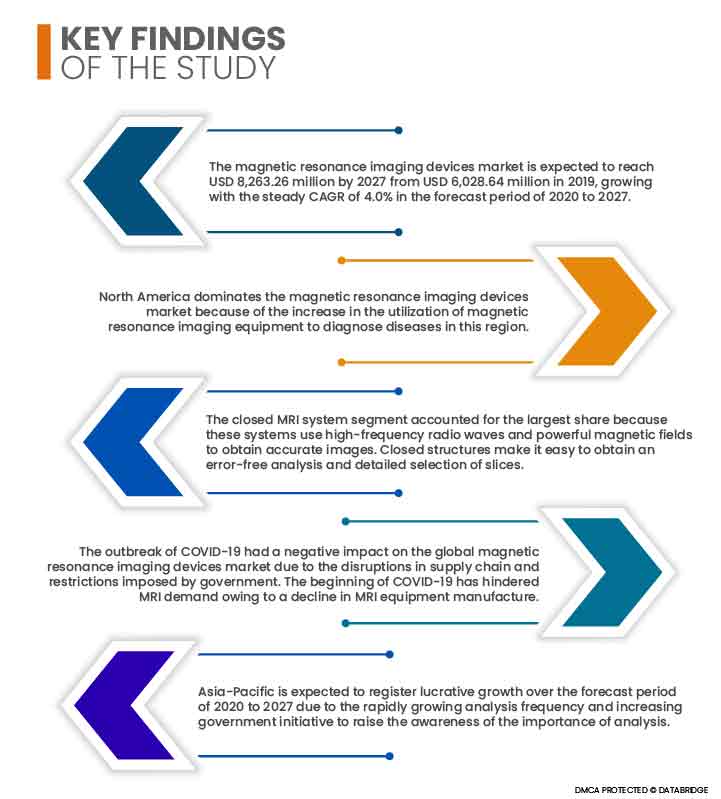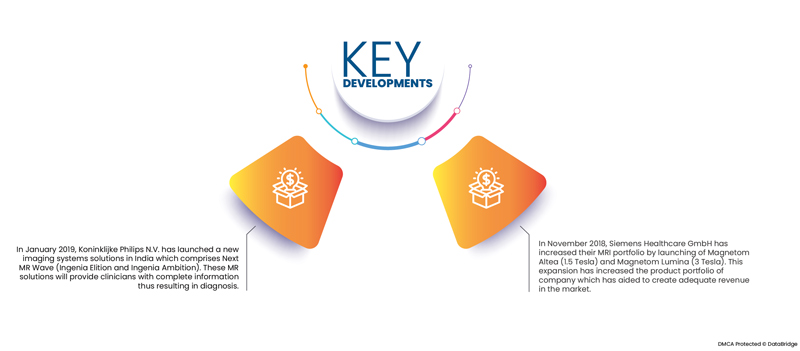만성 질환은 전 세계적으로 수많은 사람들에게 영향을 미치고 있습니다. 세계보건기구(WHO) 보고서에 따르면, 이러한 질환의 부담은 전 세계적으로 빠르게 증가하고 있습니다. 자기공명영상장치(MRI) 영상 기술은 의료 전문가가 환자를 정확하고 적절한 치료로 진단하는 데 도움이 되는 강력한 진단 기술입니다. 따라서 만성 질환의 증가는 향후 몇 년 동안 자기공명영상장치 수요를 촉진할 것으로 예상됩니다.
데이터 브릿지 마켓 리서치(Data Bridge Market Research)에 따르면, 자기공명영상(MRI) 장치 시장은 2019년 60억 2,864만 달러에서 2027년 82억 6,326만 달러로 성장할 것으로 예상되며, 2020년부터 2027년까지 4.0%의 꾸준한 CAGR로 성장할 것으로 전망됩니다. 인구 고령화와 조기 질병 진단 에 대한 인식 제고 는 시장에서 자기공명영상 장치 수요를 증가시키는 주요 요인이 될 것입니다.

전 세계적으로 증가하는 의료비 지출과 인프라가 시장 성장률을 견인할 것으로 예상 됩니다.
의료비 지출 증가와 인프라 확충은 환자가 번거롭지 않은 첨단 치료를 받을 수 있도록 돕고, 이를 통해 환자는 더 나은 치료와 진단 절차를 통해 빠른 회복을 기대할 수 있습니다. 자기공명영상장치(MRI)는 여러 유형의 질병을 검사하고 신체 질환의 정확한 원인을 파악하는 데 매우 유용합니다. 의료비 지출은 본인 부담금, 정부 지출, 그리고 비정부기구(NGO) 및 건강보험의 활동으로 구성됩니다. 의료비 지출 증가와 인프라 개선으로 최종 사용자는 첨단 자기공명영상장치(MRI)를 도입할 수 있게 되었습니다. 의료 인프라의 발전 또한 진단 센터와 병원에 첨단 고자기장 MRI 시스템 설치를 확대하여 더 정확한 진단을 위한 영상 검사를 제공하고 있습니다.
보고서 범위 및 시장 세분화
보고서 메트릭
|
세부
|
예측 기간
|
2020년부터 2027년까지
|
기준 연도
|
2019
|
역사적인 해
|
2018 (2012~2017년으로 맞춤 설정 가능)
|
양적 단위
|
매출(백만 달러), 볼륨(단위), 가격(달러)
|
다루는 세그먼트
|
자기장 강도(고자기장 MRI 시스템, 중자기장 MRI 시스템, 저자기장 MRI 시스템, 기타), 유형(폐쇄형 MRI 시스템, 광구경 MRI, 개방형 MRI 시스템), 모달리티(고정형 시스템, 휴대용/모바일 시스템, 현장 진료(POC) 시스템), 적응증(뇌 및 신경 , 근골격, 심장, 유방 조영술 , 종양, 골반 및 복부, 산부인과, 비뇨기과, 치과, 기타), 최종 사용자(병원, 진단 센터, 영상 센터, 전문 클리닉, 외래 수술 센터, 학술 및 연구 기관), 유통 채널(직접 입찰, 소매 판매)
|
포함 국가
|
미국, 북미의 캐나다 및 멕시코, 독일, 프랑스, 영국, 네덜란드, 스위스, 벨기에, 러시아, 이탈리아, 스페인, 터키, 유럽의 기타 유럽 국가, 중국, 일본, 인도, 한국, 싱가포르, 말레이시아, 호주, 태국, 인도네시아, 필리핀, 아시아 태평양(APAC)의 기타 아시아 태평양(APAC), 사우디아라비아, UAE, 남아프리카 공화국, 이집트, 이스라엘, 중동 및 아프리카(MEA)의 일부인 기타 중동 및 아프리카(MEA), 남미의 일부인 기타 남미 국가.
|
시장 참여자 포함
|
Aspect Imaging(이스라엘), CANON MEDICAL SYSTEMS CORPORATION(일본), Siemens(독일), General Electric Company(미국), Hitachi, Ltd.(일본), Koninklijke Philips NV(네덜란드), Neusoft Corporation(중국), ESAOTE SPA(이탈리아), FONAR(미국), Synaptive Medical(캐나다), AllTech Medical Systems(미국), United Imaging Intelligence(중국), Medonica Co. LTD(한국), IMRIS(캐나다), Promaxo(미국), AURORA HEALTHCARE US CORP(미국), SG HealthCare Pvt. Ltd.(인도), HYPERFINE(미국), Elekta AB(스웨덴), Beijing Wandong Medical Technology Co.,Ltd(중국), ASG Superconductors spa(이탈리아) 등
|
보고서에서 다루는 데이터 포인트
|
Data Bridge Market Research에서 큐레이팅한 시장 보고서에는 시장 가치, 성장률, 세분화, 지리적 적용 범위, 주요 기업 등 시장 시나리오에 대한 통찰력 외에도 심층적인 전문가 분석, 환자 역학, 파이프라인 분석, 가격 분석, 규제 프레임워크가 포함됩니다.
|
세그먼트 분석:
자기공명영상장치 시장은 자기장 강도, 방식, 적응증, 최종 사용자 및 유통 채널을 기준으로 세분화됩니다.
- 자기장 강도를 기준으로, 글로벌 자기공명영상장치 시장은 고자기장 MRI 시스템, 중자기장 MRI 시스템, 저자기장 MRI 시스템 및 기타로 구분됩니다.
2020년에는 자기장 강도 부문의 고자기장 MRI 시스템 부문이 고정 기술 시장을 지배할 것으로 예상됩니다.
고자기장 MRI 시스템 부문은 진단용으로 더 강력한 신호를 생성하기 때문에 83.14%의 시장 점유율로 세계 자기공명영상(MRI) 장치 시장을 장악할 것으로 예상됩니다. 이는 신경, 혈관, 정형외과 분야에 적합하며, 저자기장 MRI 시스템보다 스캔 속도가 빠릅니다.
- 전 세계 자기공명영상(MRI) 장치 시장은 유형별로 폐쇄형 MRI 시스템, 광구경 MRI, 개방형 MRI 시스템으로 구분됩니다. 2020년에는 폐쇄형 MRI 시스템 부문이 83.18%의 시장 점유율로 전 세계 자기공명영상 장치 시장을 장악할 것으로 예상됩니다. 폐쇄형 MRI 시스템은 고주파 전파와 강력한 자기장을 사용하여 정확한 영상을 얻기 때문입니다. 폐쇄형 구조 덕분에 오류 없는 분석과 세밀한 슬라이스 선택을 쉽게 할 수 있습니다.
- 전 세계 자기공명영상(MRI) 장비 시장은 방식에 따라 고정형 시스템, 휴대용/모바일 시스템, 그리고 현장진료(POC) 시스템으로 구분됩니다. 2020년에는 고정형 시스템 부문이 진단 센터와 병원에서 고정형 의료 영상 장비의 설치 및 도입이 증가함에 따라 71.58%의 시장 점유율을 기록하며 전 세계 자기공명영상 장비 시장을 주도할 것으로 예상됩니다.
- 글로벌 자기공명영상장치 시장은 지표에 따라 뇌 및 신경, 근골격, 심장학 , 유방조영술, 종양학, 골반 및 복부, 산부인과, 비뇨기과, 치과 및 기타로 세분화됩니다.
2020년에는 뇌 및 신경학 분야가 자기공명영상장치 시장에서 가장 큰 시장점유율을 차지할 것으로 전망된다.
뇌 및 신경학 분야는 MRI 장비가 환자의 인지 과제 수행 중에 뇌 구조를 스캔하고 모니터링할 수 있기 때문에 24.22%의 시장 점유율로 세계 자기공명영상(MRI) 장비 시장을 장악할 것으로 예상됩니다. 또한 MRI는 척수와 뇌의 신경 활동을 보여줍니다. 이는 신경과학 연구에 널리 사용되는 영상 기술입니다.
- 최종 사용자 기준으로 전 세계 자기공명영상(MRI) 장비 시장은 병원, 진단센터, 영상센터, 전문 클리닉, 외래 수술센터, 그리고 학술 및 연구기관으로 구분됩니다. 2020년에는 MRI 장비 설치 증가에 힘입어 병원 부문이 55.33%의 시장 점유율을 기록하며 전 세계 자기공명영상(MRI) 장비 시장을 주도할 것으로 예상됩니다. 응급 서비스 및 외상 분야에서 자기공명영상(RMRI) 프로그램에 대한 수요가 증가할 것으로 예상됩니다. 교육병원의 자기공명영상 장비 수요 증가는 향후 몇 년간 시장 성장을 더욱 가속화할 것입니다.
- 유통 채널을 기준으로 전 세계 자기공명영상(MRI) 기기 시장은 직접 입찰과 소매 판매로 구분됩니다. 2020년에는 직접 입찰 부문이 87.69%의 시장 점유율로 전 세계 자기공명영상 기기 시장을 장악할 것으로 예상되는데, 이는 대부분의 서비스 공급업체가 생산자로부터 장비를 구매하기 때문입니다. 자기공명영상 기기 시장에서 직접 판매 수익이 더 높은 것은 주목할 만한 현상입니다.
주요 플레이어
Data Bridge Market Research 에서는 Aspect Imaging(이스라엘), CANON MEDICAL SYSTEMS CORPORATION(일본), Siemens(독일), General Electric Company(미국), Hitachi, Ltd.(일본), Koninklijke Philips NV(네덜란드), Neusoft Corporation(중국), ESAOTE SPA(이탈리아), FONAR(미국), Synaptive Medical(캐나다) 등 주요 자기공명영상장치 시장 주체로 다음 회사를 인식하고 있습니다.

시장 개발
- 2019년 1월, Koninklijke Philips NV는 Next MR Wave(Ingenia Elition과 Ingenia Ambition)로 구성된 새로운 영상 시스템 솔루션을 인도에 출시했습니다. 이 MR 솔루션은 임상의에게 완벽한 정보를 제공하여 진단을 내릴 수 있도록 지원합니다. 이러한 개발을 통해 회사의 제품 포트폴리오가 확대되어 적정 매출을 창출할 수 있었습니다.
- 2018년 11월, 지멘스 헬스케어(Siemens Healthcare GmbH)는 Magnetom Altea(1.5테슬라)와 Magnetom Lumina(3테슬라)를 출시하여 MRI 포트폴리오를 확장했습니다. 이러한 확장을 통해 회사의 제품 포트폴리오가 확대되어 시장에서 적정 매출을 창출하는 데 기여했습니다.
지역 분석
지리적으로, 자기공명영상장치 시장 보고서에서 다루는 국가는 북미의 미국, 캐나다 및 멕시코, 유럽의 독일, 프랑스, 영국, 네덜란드, 스위스, 벨기에, 러시아, 이탈리아, 스페인, 터키, 유럽의 기타 유럽, 중국, 일본, 인도, 한국, 싱가포르, 말레이시아, 호주, 태국, 인도네시아, 필리핀, 아시아 태평양(APAC)의 기타 아시아 태평양(APAC), 사우디아라비아, UAE, 남아프리카 공화국, 이집트, 이스라엘, 중동 및 아프리카(MEA)의 일부인 기타 중동 및 아프리카(MEA), 남미의 일부인 기타 남미입니다.
Data Bridge Market Research 분석에 따르면:
북미는 2020년부터 2027년까지의 예측 기간 동안 자기공명영상장치 시장 에서 주도적인 지역입니다.
북미는 질병 진단을 위한 자기공명영상(MRI) 장비 활용 증가로 자기공명영상(MRI) 장비 시장을 주도하고 있습니다. 더욱이, 만성 질환 유병률 증가는 자기공명영상(MRI) 장비 시장의 성장을 더욱 가속화할 것입니다.
아시아 태평양 지역은 2020년부터 2027년까지 자기공명영상장치 시장에서 가장 빠르게 성장하는 지역으로 추정됩니다.
아시아 태평양 지역은 MRI 장비 수요 증가로 2022년부터 2029년까지 예측 기간 동안 가장 빠르게 성장하는 지역이 될 것으로 예상됩니다. 또한, 분석 빈도가 빠르게 증가하고 분석의 중요성에 대한 인식을 높이기 위한 정부 정책이 강화됨에 따라 이 지역 시장 성장이 더욱 가속화될 것으로 예상됩니다.
COVID-19 영향 분석
코로나19 발발은 공급망 차질과 정부 규제로 인해 자기공명영상(MRI) 장비 시장에 부정적인 영향을 미쳤습니다. 코로나19 발발 초기 MRI 장비 생산 감소로 MRI 수요가 위축되었습니다. 이러한 팬데믹으로 인해 주요 시장 참여업체들의 시장 매출이 크게 감소했습니다. MRI 장비 판매는 환자 방문 감소, 의료 자원 감소, 공급망 차질 및 기타 주요 요인의 재분배에 영향을 받았습니다. 그러나 이전에 시행된 제한 조치가 완화됨에 따라 시장은 팬데믹 이후 성장세를 회복할 것으로 예상됩니다.
자기공명영상장치 시장 보고서 에 대한 자세한 내용은 여기를 클릭하세요 - https://www.databridgemarketresearch.com/reports/global-magnetic-resonance-imaging-devices-market










